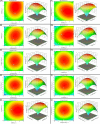Enhancing bioprocessing of red pigment from immobilized culture of gamma rays mutant of the endophytic fungus Monascus ruber SRZ112
- PMID: 39148082
- PMCID: PMC11325623
- DOI: 10.1186/s13036-024-00439-y
Enhancing bioprocessing of red pigment from immobilized culture of gamma rays mutant of the endophytic fungus Monascus ruber SRZ112
Abstract
Considerable attention has been paid to exploring the biotechnological applications of several Monascus sp. for pigment production. In this study, our focus is on enhancing the bioprocessing of red pigment (RP) derived from the endophytic fungus Monascus ruber SRZ112. To achieve this, we developed a stable mutant strain with improved productivity through gamma irradiation. This mutant was then employed in the immobilization technique using various entrapment carriers. Subsequently, we optimized the culture medium for maximal RP production using the Response Surface Methodology. Finally, these immobilized cultures were successfully utilized for RP production using a semi-continuous mode of fermentation. After eight cycles of fermentation, the highest RP yield by immobilized mycelia reached 309.17 CV mL-1, a significant increase compared to the original titer. Importantly, this study marks the first report on the successful production of Monascus RP in a semi-continuous mode using gamma rays' mutant strain, offering prospects for commercial production.
Keywords: Monascus ruber; Endophytic fungi; Gamma Radiation Mutagenesis; Immobilization; Red pigment; Response Surface Methodology.
© 2024. The Author(s).
Conflict of interest statement
The authors declare no financial or commercial conflict of interest.
Figures




Similar articles
-
Novel nanoconjugates of metal oxides and natural red pigment from the endophyte Monascus ruber using solid-state fermentation.Microb Cell Fact. 2024 Sep 29;23(1):259. doi: 10.1186/s12934-024-02533-8. Microb Cell Fact. 2024. PMID: 39343880 Free PMC article.
-
A new endophyte Monascus ruber SRZ112 as an efficient production platform of natural pigments using agro-industrial wastes.Sci Rep. 2022 Jul 23;12(1):12611. doi: 10.1038/s41598-022-16269-1. Sci Rep. 2022. PMID: 35871189 Free PMC article.
-
Production of the anticancer drug taxol by the endophytic fungus Epicoccum nigrum TXB502: enhanced production by gamma irradiation mutagenesis and immobilization technique.Appl Microbiol Biotechnol. 2020 Aug;104(16):6991-7003. doi: 10.1007/s00253-020-10712-x. Epub 2020 Jul 2. Appl Microbiol Biotechnol. 2020. PMID: 32617617
-
Sugarcane bagasse hydrolysate as a potential feedstock for red pigment production by Monascus ruber.Food Chem. 2018 Apr 15;245:786-791. doi: 10.1016/j.foodchem.2017.11.111. Epub 2017 Dec 2. Food Chem. 2018. PMID: 29287441
-
Synthetic biology for Monascus: From strain breeding to industrial production.Biotechnol J. 2024 Jul;19(7):e2400180. doi: 10.1002/biot.202400180. Biotechnol J. 2024. PMID: 39014924 Review.
Cited by
-
Bioprospecting Endophytic Fungi of Forest Plants for Bioactive Metabolites with Antibacterial, Antifungal, and Antioxidant Potentials.Molecules. 2024 Oct 8;29(19):4746. doi: 10.3390/molecules29194746. Molecules. 2024. PMID: 39407685 Free PMC article.
-
Novel nanoconjugates of metal oxides and natural red pigment from the endophyte Monascus ruber using solid-state fermentation.Microb Cell Fact. 2024 Sep 29;23(1):259. doi: 10.1186/s12934-024-02533-8. Microb Cell Fact. 2024. PMID: 39343880 Free PMC article.
-
Bioprospecting endophytic fungi of forest plants for bioactive metabolites with anticancer potentials.Sci Rep. 2025 Jul 21;15(1):26423. doi: 10.1038/s41598-025-10372-9. Sci Rep. 2025. PMID: 40691195 Free PMC article.
References
-
- Lopes FC, Ligabue-Braun R. Agro-industrial residues: eco-friendly and inexpensive substrates for microbial pigments production. Front Sustain Food Syst. 2021;5: 589414. 10.3389/fsufs.2021.589414.10.3389/fsufs.2021.589414 - DOI
-
- Agboyibor C, Kong W, Chen D, Zhang A, Niu S. Monascus pigments production, composition, bioactivity and its application: a review. Biocatal Agric Biotechnol. 2018;16:433–47. 10.1016/j.bcab.2018.09.012.10.1016/j.bcab.2018.09.012 - DOI
LinkOut - more resources
Full Text Sources

